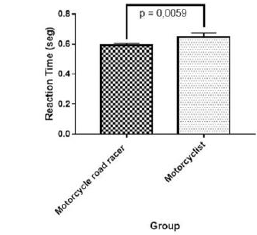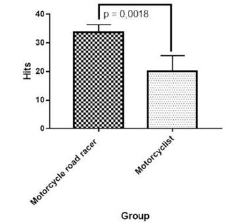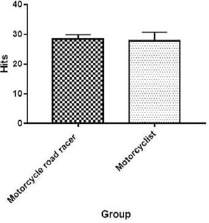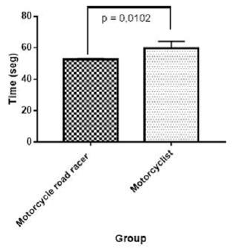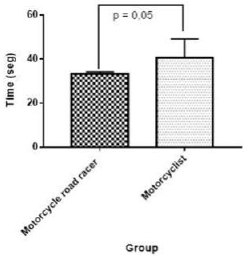Abstract
Objective: To compare reaction time of Track Day racers with motorcyclists.
Method: 10 volunteers were studied (five motorcycle racer 29.4 + 2.6 years and
five motorcyclists 22 + 1.4 years). The reaction time (RT) was evaluated in two tests:
T1) Specific test, performed with the volunteer performed on a motorcycle and T2)
Non-specific test, performed in a simple task. In both tests, the average reaction time
was performed (in milliseconds); Number of Hits and Total Task Execution Time (in
seconds).
Results: In the specific test of reaction time the Track Day racers group was faster
than the motorcyclist’s group (0.592 + 0.014 vs. 0.646 + 0.029 ms, p = 0.0059), as well
as racers normally more hits (33.6 + 2.79 vs. 17.8 + 6.83, p = 0.0018) and shorter total
time to perform the test (52.64 + 6.65 vs. 59.52 + 4, 55 seconds, p = 0.0102). No nonspecific
tests or performance between the two groups were detected, except for the
total time to perform the test, or which was shorter for the Track Day tests (33.17 +
1.0665 vs. 40.65 + 8, 46 seconds, p = 0.05).
Conclusion: Track Day racers showed the best reaction time, the number of hits
and the task execution time that the motorcyclists.
Keywords: Reaction Time; Racing Driver; A Motorcyclist; Exercise; An Experimental Study
Introduction
Motorbike speed is one of the most popular sports in the
world, which requires excellent physical and mental performance
from the racers. However, the importance of applying the Theory
of Sports Training in the sport is little explored, especially in the
amateur categories. The lack of information occurs due to the
little involvement of Sports Medicine and Sports Sciences in the
different categories of motorbike [1]. It is recognized that this sport
is extremely challenging and dangerous [2,3]. The motorbike racers
is exposed to extreme conditions and high physical demands, on
the other hand, in motorsports, the victories depend, not only on
the individual physical capacity of the athlete but on a set of factors,
such as riding technique, mental effort, equipment efficiency and
resistance, race strategy and team competence [4].
Even though physical fitness is not the main determinant for
win in Motor Sports, it is still observed that training and racing
require athletic skills and physical demands from the driver, similar to athletes in other sports [5]. In this sense, Ebben, et al. [6] point
out that the aerobic resistance of racer drivers is similar to that of
boxing, basketball, football, athletics, among others. Reaction Time
(RT) is the time interval between the generation of visual, audible
or tactile stimuli and motor action. This time revolves around values
that correspond to milliseconds and depends on factors such as age,
physical conditioning, cognitive level, emotional state and gender
[7]. Although Reaction Time is related to genetic conditions, it is
a sensory quality that can be trained. High-performance athletes
can achieve a decrease of approximately 15% in reaction time
due to years of training [8]. For the athlete to react to a stimulus,
there is a latency period (just before muscle contraction begins),
which is shorter or slower due to the quality of the processing of
the reference by the central nervous system [7]. It is observed that
the RT of elite athletes, is faster when compared to beginners or
untrained [9].
According to Tønnessen, et al. [10], in a study comparing the
reaction time of 1,319 world champions in the 100-meter dash
category, it was observed that the RT of male athletes (0.166 ±
0.030 seconds) was significantly lower than that of female athletes
(0.176 ± 0.034 seconds). There was no relationship between RT
and height. The best RT was obtained in the age group between
26 and 29 years old in males (0.150 ± 0.017 seconds) and athletes
over 30 years old (0.153 ± 0.020 seconds). According to Sparrow,
et al. [11], the type of training, testing and the modality practiced
by the athlete can influence RT. Gélat, et al. [12] point out that
the emotional and attention state interferes with RT, which can
be faster, in motivating conditions and/or when the individual
remains more attentive and slower, in situations of demotivation
or depression. The neurosensory response is extremely important
for Motor Sports racers, such as motorcycle race. Being that during
races the racers receives different visual, auditory, tactile stimuli
and the respective reception, transfer, processing and transfer of
this information, in the shortest possible time, are essential for the
performance during the competitions.
Objective
To compare reaction time of Track Day racers with motorcyclists.
Method
Sample Characteristics
The accessibility sample consisted of 10 volunteers, who were divided into two groups with five individuals each: G1) Amateur Track Day racers 29.4 + 2.6 years old and G2) Motorcyclists, without experience in motorcycle competitions, with an average age of 22 + 1.4 years.
Inclusion Criteria
• Motorbike racers: participation in at least six Track Day races
between 2018 and 2019; male; physically active; age over 18
years; signing the Free and Informed Consent Form (ICF).
• Motorcyclists: National Driver’s License Category A; use of
the motorcycle as a means of transportation at least four times
a week between the years 2018 and 2019; male; physically
active; age over 18 years; signing the Free and Informed
Consent Form (ICF).
Exclusion Criteria
Any type of injury that makes bodily movements impossible. Consumption of substances with caffeine two hours from the tests. Do not accept to participate in the research.
Ethical Procedures
The research project was submitted to and approved by the Research Ethics Committee of the School of Physical Education of Jundiaí (Jundiaí, São Paulo/Brazil) Protocol Number 3.401.727 and all volunteers signed the IC to participate in the study.
Experimental Procedures
To evaluate the Reaction Time, FITLIGHT® system was used,
a device that allows the random activation of up to eight LEDs,
wirelessly, according to the programming of the respective lighting
time and activation time determined by the researcher, with the
registration of the number of hits and reaction time in milliseconds.
The equipment allows identifying, besides the Reaction Time, other
variables such as several correct answers in the tasks as well as the
total activity time. The equipment’s different schedules have the
potential to quantify Reaction Time, as well as to develop specific
exercises or activities that simulate real movements during the
specific movement of various sports.
The study volunteers underwent two tests performed
sequentially to identify the Reaction Time: T1) specific test
performed on a Honda CBR 600cc motorcycle, supported on a
specific easel, where each rider and motorcyclist remained in the
riding position responding to luminous signs of the LEDs that
were positioned laterally (left and right side) at the height of the
volunteer’s eyes and two others on the ground beside the front tire,
during the test the objective of turning the handlebar left or right
or directing the left hand or right as the LEDs are being turned on
randomly; T2) non-specific test, with the led’s positioned in front
of each individual on a bench, the objective being to direct the right
or left hand to each random lighting of the led for the respective
Reaction Time record. In the two tests, the respective positions of the subjects were standardized. Each test has a total of 30 random
LEDs, with an estimated time to complete each task of around
thirty-five seconds. The variables obtained in each task were:
average Reaction Time (in milliseconds), the number of hits and
errors, that is, if the volunteer was able to respond to the stimulus
in the time that the LEDs remained on (0.500 ms), as well as the
total test run time.
Data Analysis
For comparison between moments, Student’s t-test paired for variables with normal distribution was used, with Bonferroni’s post-test adopting a 5% significance level for all analyzes. Using the Graph Pad software. The data were also presented descriptively in graphical and tabular form.
Results
Graphs 1-6 show the results obtained in the present study. It can be seen that in the specific test the Track Day racers performed better than the motorcyclists concerning the following variables: reaction time, number of hits and total time to perform the task. However, in test 2 considered as a non-specific evaluation of the TR, there was no statistical difference in the variables studied, except in the total time to perform the task, which was significantly less in favor of the Track Day racers (Graphs 1-6).
Discussion
The identification of the reaction time levels of a sports modality
must follow its characteristics and physiological influences in its
execution. For Backman, et al. [13], in Motor Sports, the effect of
driving the vehicle on the locomotor system and the muscular effort
in its entirety during practice should be considered. In this sense,
it can be inferred that in the motorbike the dynamic component
of the modality is characterized by the great demand for body
displacement during the practice, that is, use of the muscles of
the trunk, abdomen and upper limbs for driving, acceleration,
clutch control and motorcycle braking and use of the lower limbs
together with the pelvic girdle muscles for positioning in curves,
braking and downshifting. The static component is also observed,
concerning the core and shoulder girdle muscles, and the modality
is considered to have a vigorous level of physical effort, due to
the high level of dehydration, above-average heart rate and high
probability of falling and risk of collisions. In this sense, familiarity
with the equipment during the specific test may be one of the
reasons for the better performance of the racers compared to
motorcyclists. However, Track Day racers did not train Reaction
Time in their weekly exercise routine. Inferring that the best results
obtained in the specific test are related to the practice of the sport,
according to the principle of specificity [14].
Remaud, et al. [15] highlighted the demands for attention
associated with postural control during Reaction Time and
considered that both the focus of attention and the difficulty of a
postural task are potential factors that influence RT. The authors
evaluated thirteen young people in two tests that consisted of
being as quiet as possible on a force platform in different postural
conditions, while simultaneously performing a simple TR task. The
difficulty of the postural task was handled by various combinations
of three support bases (feet together, apart and single leg) and
two visual conditions (eyes open and closed). Participants were
instructed to focus on balance or performance on RT, depending on
the test session. Participants responded more quickly in all dualtask
conditions by focusing on TR performance than on balance. The
modified attention allocation index indicated that the participants’
ability to modulate their allocation of attentional resources to
respond positively to instruction was more pronounced in the most
challenging postural condition. This can explain in our study, the
better performance of Track Day racers in the task performed in the
riding position and on a motorcycle of a similar model to the one
that is usually used in their routines.
These results indicate that Track Day racers concerning the
reactions on the motorcycle stand out from the racers, as expected
due to the experience on the tracks and familiarity with the model
of the motorcycle that was used as a reference for carrying out the
tests. A similar result was observed in the study by Van Leeween,
et al. [16], where racers drivers were better in all measures of
reaction time compared to drivers. On the other hand, in the nonspecific
test, the performance of the two groups of motorcyclists
was equivalent, but with a noticeable difference in terms of the test
execution time.
Practical Applications
For a motorcyclist to participate in the Track Day, the racers don’t need to have experience in racing tracks and/or to have taken a Riding Course and a motorcycle-specific preparation for competitions is also not necessary. Due to these facilities, many motorcyclists, even without the proper preparation to enter a racetrack, are attracted to participate in these races, in some cases with rented competition motorcycles. Our data showed that, for example, the Reaction Time of racers experienced in this type of event is higher than that of motorcyclists who, although experienced, never participated in Track Day. In this sense, the results of this study indicate that it is not enough for the rider alone have experience of daily use of motorcycles in traffic, as the specificity of the riding position seems to significantly interfere in the Reaction Time test. In this sense, it is suggested that motorcyclists who have never participated in Track Day should take courses and training before starting the practice. On the other hand, we suggest that the specific test protocol used in the present study to evaluate the Reaction Time can be used for the evaluation and/or training of motorbike racers.
Conclusion
It was observed that the Track Day racers presented the best reaction time, number of hits and time of execution of the task than the racers in the specific test. However, in the non-specific reaction time test, there was no significant difference between the volunteers studied, except in the time of the test, where the Track Day racers were faster. These data contribute to reinforce the importance of specificity in motorsports and to the establishment of benchmarks concerning the reaction time of motorbike racers.
Acknowledgment
FITLIGHT® System – Ontario/Canada.
References
- White HD, Chew DP (2008) Acute myocardial infarction. Lancet 372(9638): 570-584.
- Shaw LJ, Hausleiter J, Achenbach S, Al Mallah M, Berman DS, et al. (2012) Coronary computed tomographic angiography as a gatekeeper to invasive diagnostic and surgical procedures: results from the multicenter CONFIRM (Coronary CT Angiography Evaluation for Clinical Outcomes: an International Multicenter) registry. J Am Coll Cardiol 60(20): 2103-2014.
- Nasis A, Mottram PM, Cameron JD, Seneviratne SK (2013) Current and evolving clinical applications of multidetector cardiac CT in assessment of structural heart disease. Radiology 267(1): 11-25.
- Norgaard BL, Hansson NC, Christiansen EH, Kaltoft A, Botker HE, et al. (2015) A "normal" invasive coronary angiogram may not be normal. J Cardiovasc Comput Tomogr 9(4): 264-266.
- Nieman K, Balla S (2020) Dynamic CT myocardial perfusion imaging. J Cardiovasc Comput Tomogr 14(4): 303-306.
- Magalhaes TA, Kishi S, George RT, Arbab Zadeh A, Vavere AL, et al. (2015) Combined coronary angiography and myocardial perfusion by computed tomography in the identification of flow-limiting stenosis The CORE320 study: An integrated analysis of CT coronary angiography and myocardial perfusion. J Cardiovasc Comput Tomogr 9(5): 438-445.
- Kikano EG, Rajdev M, Salem KZ, Laukamp K, Felice CD, et al. (2020) Utility of Iodine Density Perfusion Maps From Dual-Energy Spectral Detector CT in Evaluating Cardiothoracic Conditions: A Primer for the Radiologist. AJR Am J Roentgenol 214(4): 775-785.
- Machida H, Tanaka I, Fukui R, Shen Y, Ishikawa T, et al. (2016) Dual-Energy Spectral CT: Various Clinical Vascular Applications. Radiographics 36(4): 1215-1232.
- Adam SZ, Rabinowich A, Kessner R, Blachar A (2021) Spectral CT of the abdomen: Where are we now? Insights Imaging 12(1): 138.
- Li WX, Miao F, Xu XQ, Zhang J, Wu ZY, et al. (2021) Pancreatic Neuroendocrine Neoplasms: CT Spectral Imaging in Grading. Acad Radiol 28(2): 208-216.
- Silva AC, Morse BG, Hara AK, Paden RG, Hongo N, et al. (2011) Dual-energy (spectral) CT:applications in abdominal imaging. Radiographics 31(4): 1031-1046.
- Matsumoto K, Jinzaki M, Tanami Y, Ueno A, Yamada M, et al. (2011) Virtual monochromatic spectral imaging with fast kilovoltage switching: improved image quality as compared with that obtained with conventional 120-kVp CT. Radiology 259(1): 257-262.
- Kaza RK, Platt JF, Cohan RH, Caoili EM, Al Hawary MM, et al. (2012) Dual-energy CT with single- and dual-source scanners: current applications in evaluating the genitourinary tract. Radiographics 32(2): 353-369.
- Zhang Z, Takarada S, Molloi S (2011) Quantification of coronary microvascular resistance using angiographic images for volumetric blood flow measurement: in vivo Am J Physiol Heart Circ Physiol 300(6): H2096-2104.
- Cerqueira MD, Weissman NJ, Dilsizian V, Jacobs AK, Kaul S, et al. (2002) Standardized myocardial segmentation and nomenclature for tomographic imaging of the heart. A statement for healthcare professionals from the Cardiac Imaging Committee of the Council on Clinical Cardiology of the American Heart Association. Circulation 105(4): 539-542.
- Nensa F, Poeppel TD, Beiderwellen K, Schelhorn J, Mahabadi AA, et al. (2013) Hybrid PET/MR imaging of the heart: feasibility and initial results. Radiology 268(2): 366-373.
- Packard GC, Boardman TJ (2008) Model selection and logarithmic transformation in allometric analysis. Physiol Biochem Zool 81(4): 496-507.
- Fahmi R, Eck BL, Levi J, Fares A, Dhanantwari A, et al. (2016) Quantitative myocardial perfusion imaging in a porcine ischemia model using a prototype spectral detector CT system. Phys Med Biol 61(6): 2407-2431.
- Rodriguez Granillo GA, Campisi R, Deviggiano A, de Munain MNL, Zan M, et al. (2017) Detection of Myocardial Infarction Using Delayed Enhancement Dual-Energy CT in Stable Patients. AJR Am J Roentgenol. 209(5): 1023-1032.
- Pessis E, Campagna R, Sverzut JM, Bach F, Rodallec M, et al. (2013) Virtual monochromatic spectral imaging with fast kilovoltage switching: reduction of metal artifacts at CT. Radiographics 33(2): 573-583.
- Luo G, Jian Z, Zhu Y, Zhu Y, Chen B, et al. (2019) Sirt1 promotes autophagy and inhibits apoptosis to protect cardiomyocytes from hypoxic stress. Int J Mol Med 43(5): 2033-2043.
- Yu SY, Dong B, Fang ZF, Hu XQ, Tang L, et al. (2018) Knockdown of lncRNA AK139328 alleviates myocardial ischaemia/reperfusion injury in diabetic mice via modulating miR-204-3p and inhibiting autophagy. J Cell Mol Med 22(10): 4886-4898.
- Kang PM, Izumo S (2003) Apoptosis in heart: basic mechanisms and implications in cardiovascular diseases. Trends Mol Med 9(4): 177-182.
- Kim NH, Kang PM (2010) Apoptosis in cardiovascular diseases: mechanism and clinical implications. Korean Circ J 40(7): 299-305.
- Zhao ZQ (2004) Oxidative stress-elicited myocardial apoptosis during reperfusion. Curr Opin Pharmacol 4(2): 159-165.
- Sharov VG, Sabbah HN, Shimoyama H, Goussev AV, Lesch M, et al. (1996) Evidence of cardiocyte apoptosis in myocardium of dogs with chronic heart failure. Am J Pathol 148(1): 141-149.
- Dorweiler B, Pruefer D, Andrasi TB, Maksan SM, Schmiedt W, et al. (2007) Ischemia-Reperfusion Injury: Pathophysiology and Clinical Implications. Eur J Trauma Emerg Surg 33(6): 600-612.
- Caiazzo G, Musci RL, Frediani L, Uminska J, Wanha W, et al. (2020) State of the Art: No-Reflow Phenomenon. Cardiol Clin 38(4): 563-573.
- Allencherril J, Jneid H, Atar D, Alam M, Levine G, et al. (2019) Pathophysiology, Diagnosis, and Management of the No-Reflow Phenomenon. Cardiovasc Drugs Ther 33(5): 589-597.

 Research Article
Research Article